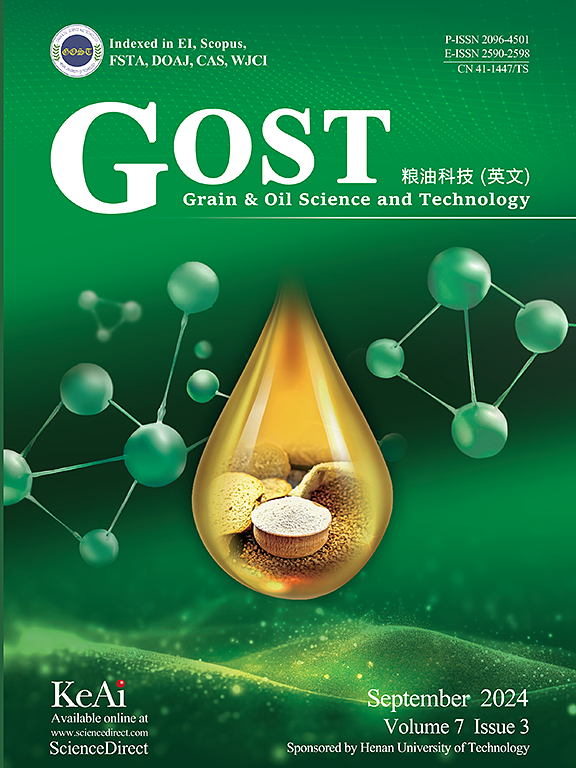Insight into the physicochemical characteristics and biological features of dietary polysaccharides extracted from palm kernel cake
Q2 Agricultural and Biological Sciences
引用次数: 0
Abstract
Palm kernel cake (PKC), a major by-product of the palm oil industry, is rich in non-starch polysaccharides. In this study, two polysaccharide fractions, precipitated with acetic acid (PPA) and ethanol (PPE), respectively, were extracted from PKC using a 2 mol/L NaOH solution. The molecular weight, sugar composition, structural characteristics, morphology, antioxidant activity, as well as in vitro stimulated digestion were investigated in detail. The results revealed that due to its poor solubility of PPA in water, the detected molecular weight of PPA was only 2040 g/mol, which was significantly lower than that of PPE (65,300 g/mol). Although PPA and PPE had a similar sugar composition with varying contents, mannose was the predominant monosaccharide in both, accounting for 87.71% and 60.40%, respectively. Both PPA and PPE were primarily composed of crystalline mannan, consisting of mannopyranosyl units linked by (1→4)-β-glycosidic bonds, along with a small amount of lignin. PPA possibly contained a higher proportion of crystalline mannan, whereas PPE had a larger amount of arabinoxylan and galactomannan. Atomic force microscope revealed a stacked morphology for both PPA and PPE. PPA exhibited a higher scavenging rate against DPPH• and ABTS+• but a weaker HO• scavenging activity and reducing power compared with PPE. Within the polysaccharide concentration range of 0.5–5.0 mg/mL, PPA and PPB demonstrated the strongest scavenging activity against ABTS+•, with the highest scavenging rates exceeding 91%. However, PPA and PPB exhibited the weakest scavenging activity against HO•, with their highest HO• scavenging rates reaching only 44.91% and 55.86%, respectively. The antioxidant activities of both PPA and PPE were weaker than that of ascorbic acid. PPA remained almost stable in the in vitro simulated saliva fluid, while PPE exhibited weaker resistance to it. Both PPA and PPE exhibited weak resistance to the in vitro simulated gastric digestion fluids, but remained relatively stable in the in vitro simulated small-intestinal digestion fluid. The differences in physicochemical properties between PPA and PPE likely played an important role in their distinct biological activities. These findings suggest potential utilization of PKC in exploring dietary polysaccharides with favorable antioxidant activity and unique digestive characteristics.

棕榈仁饼中提取的膳食多糖的理化特性和生物学特性
棕榈仁饼(PKC)是棕榈油工业的主要副产品,富含非淀粉多糖。本研究采用2mol /L的NaOH溶液,分别用乙酸(PPA)和乙醇(PPE)沉淀,从PKC中提取多糖。对其分子量、糖组成、结构特征、形态、抗氧化活性及体外促消化进行了详细的研究。结果显示,由于PPA在水中的溶解度较差,PPA的检测分子量仅为2040 g/mol,明显低于PPE的65,300 g/mol。虽然PPA和PPE的糖组成相似,但含量不同,但两者中甘露糖均为优势单糖,分别占87.71%和60.40%。PPA和PPE主要由结晶甘露聚糖组成,甘露聚糖由(1→4)-β-糖苷键连接的甘露吡喃基单元以及少量木质素组成。PPA可能含有较多的结晶甘露聚糖,而PPE含有较多的阿拉伯木聚糖和半乳甘露聚糖。原子力显微镜下发现PPA和PPE均呈堆叠形态。与PPE相比,PPA对DPPH•和ABTS+•具有较高的清除率,但对HO•的清除率和还原能力较弱。在0.5 ~ 5.0 mg/mL的多糖浓度范围内,PPA和PPB对ABTS+•的清除率最强,最高清除率超过91%。而PPA和PPB对HO•的清除率最弱,最高的HO•清除率分别只有44.91%和55.86%。PPA和PPE的抗氧化活性均弱于抗坏血酸。PPA在体外模拟唾液液中基本保持稳定,PPE对其抵抗力较弱。PPA和PPE对体外模拟胃消化液均表现出较弱的抗性,但在体外模拟小肠消化液中仍保持相对稳定。PPA和PPE在物理化学性质上的差异可能对其不同的生物活性起重要作用。这些发现表明PKC在探索具有良好抗氧化活性和独特消化特性的膳食多糖方面具有潜在的应用前景。
本文章由计算机程序翻译,如有差异,请以英文原文为准。
求助全文
约1分钟内获得全文
求助全文
来源期刊

Grain Oil Science and Technology
Food Science
CiteScore
7.30
自引率
0.00%
发文量
69
审稿时长
12 weeks
期刊介绍:
 求助内容:
求助内容: 应助结果提醒方式:
应助结果提醒方式:


